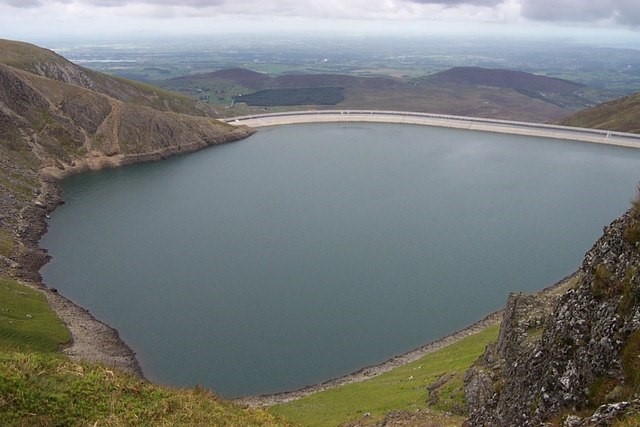Electricity storage in the UK has the potential to improve energy security and increase the use of low carbon electricity. Currently Wales provides the majority of electricity storage, with a single pumped hydroelectric storage facility, Dinorwig, contributing over half of the UK total storage capacity of approximately 3,000 MW (peak electricity use in the UK is around 50,000 MW). However, the landscape is changing rapidly with the potential for up to 12,000 MW of battery capacity to be installed by the end of 2021.
The need for electricity storage
With the move towards decarbonisation of the energy system, the UK grid is increasingly reliant on intermittent renewables. A quarter of electricity produced in the UK in 2016 was from renewable sources and Wales is aiming to produce 70% of the electricity it uses from renewable energy by 2030, having reached 40% by the end of 2016. The majority of renewable electricity comes from either wind or solar, both of which are dependent on weather conditions. As a result peak generation often does not line up with peak demand, a problem that storage can help overcome.
A study by Imperial College and the Carbon Trust showed that electricity storage could save the UK up to £2.4 billion/year by 2030. It achieves this through several different means:
- “Time-shifting” the electricity produced by wind and solar to peak demand periods;
- Increasing total capacity of the grid, needed to avoid blackouts; and
- Reducing the demand on bottlenecks in the transmission network, preventing costly upgrades.
Pumped hydroelectric storage
Pumped hydroelectric storage (PHES) operates by pumping water between two bodies of water. Overnight, water is pumped uphill using cheap electricity to power the pumps then, during periods of peak demand, the water is then run downhill through the turbines to generate electricity. PHES schemes typically operate at around 70-80% efficiency but require specific geography that allows large volumes of water to be transferred.
PHES currently provides over 90% of the electricity storage capacity for the UK. Dinorwig (1,800 MW) and Ffestiniog (360 MW) in Wales make up the majority of the 2,800 MW of PHES in the UK. Both of these facilities were built for the purpose of fast reserve, meeting sharp, short-term demand peaks. As a result they have very rapid response rates (Dinorwig can go from 0 to 1,300 MW in 12 seconds).
 Image from Geograph by Terry Hughes and licensed for reuse under Creative Commons.
Image from Geograph by Terry Hughes and licensed for reuse under Creative Commons.
Work on a new 100 MW PHES at Glyn Rhonwy is due to begin this year. There are new PHES plants, conversions from conventional hydroelectric power and expansions to existing PHES plants planned in Scotland too. This reflects the movement towards PHES as a means to overcome the intermittent electricity supply from renewables. There are several more sites in Wales that have suitable geography to accommodate PHES schemes. Limitations currently holding back further schemes include the high capital cost and difficulties in securing planning permission.
The battery revolution
One alternative to PHES is grid-scale battery storage (PDF, 801 kB). This has the advantage of higher cycle efficiency (>90%), reducing energy loss during storage. The possibility of using battery for grid-scale energy storage has been driven forward by rapidly falling costs associated with the development of new technologies and the increasing scale of production for electric vehicles.
Only 100 MW of battery storage had been installed on the UK grid up to November 2017, however, there are a number of projects due to begin operating in 2018, resulting in a tripling of market size in just a few months. GE is planning to build a 41 MW plant in the Midlands and Vattenfall is installing 22 MW of batteries at the Pen y Cymoedd wind farm. Co-locating batteries alongside wind turbines aims to provide a significant saving in costs through sharing transmission infrastructure.
In addition to large scale battery, there is a possibility for a distributed network of batteries to be used to provide storage for the grid. Currently battery packs installed alongside solar have a relatively long payback time of 20 years and present a less attractive business case than grid-scale battery co-located with wind farms. However, with the rapidly growing market in electric vehicles, there is the possibility for vehicle-to-grid charging. This would use smart chargers to allow batteries in electric vehicles to be used as a storage network. Electric vehicle owners would be able to extract additional value by using spare battery capacity to buy electricity at times of excess supply and sell during peak demand.
Facilitating change
The Imperial College and Carbon Trust study found that two key barriers for investors in electricity storage were the market frameworks and policy risk. Ofgem and the UK government launched a smart energy plan last July.
This aims to remove some of the obstacles for storage such as being double charged transmission fees. However, some previous UK government policies such as the capacity market, did not produce the desired change and resulted in the majority of these subsidies going to fossil fuel plants.
The Welsh Government is responsible for planning decisions for electricity generating stations of 10-50 MW as developments of national significance (see Research Service Planning Series 17). This is likely to include most grid-scale battery installations. Following commencement of section 39 of the Wales Act 2017, this will be extended up to 350 MW, leading to planning for most PHES schemes coming under the remit of the Welsh Government. This is a significant change since concern over securing planning is frequently an obstacle for PHES.
The Research Service acknowledges the parliamentary fellowship provided to Robert Abernethy by the Engineering and Physical Sciences Research Council (EPSRC), which enabled this briefing paper to be completed.
Article by Robert Abernethy, National Assembly for Wales Research Service






